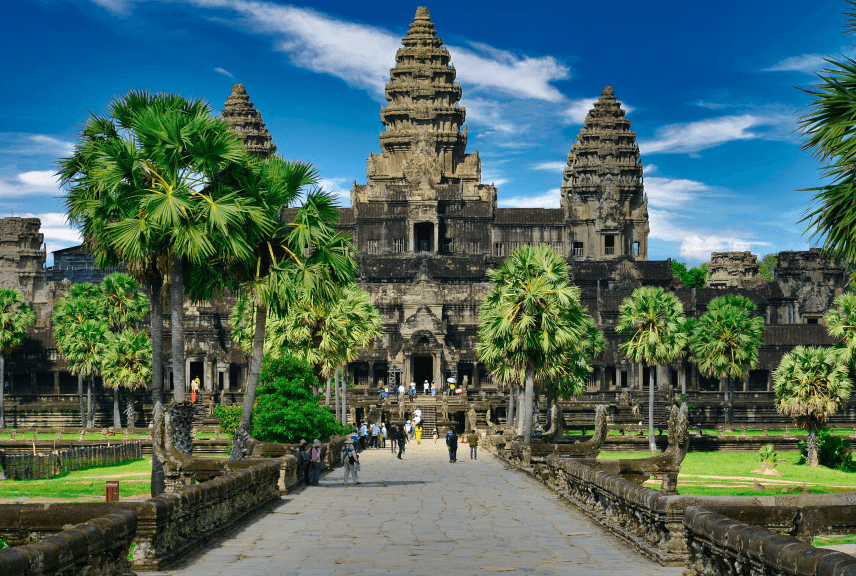Vietnam » Danang Hotels
The city’s origins date back to the ancient Champa Kingdom, established in 192 AD. At its peak, the Chams’ sphere of influence stretched from Huế to VÅ©ng Tàu. The city of Indrapura, at the site of the modern village of Dong Duong in Quang Nam province (about 50 km (31 mi) from Da Nang), was the capital of Champa from about 875 to about 1000 AD. Also in the region of Da Nang were the ancient Cham city of Singhapura (“City of the Lion”), the location of which has been identified with an archeological site in the modern village of Trà Kiệu, and the valley of Mỹ SÆ¡n, where a number of ruined temples and towers can still be viewed.
In the latter half of the 10th century, the kings of Indrapura came into conflict with the Äại Việt, who were then based at Hoa Lu near modern Hanoi. In 982, three ambassadors sent to Champa by King Lê Hoàn of the Äại Việt (founder of the Early Lê Dynasty) were detained in Indrapura. Lê Hoàn decided to go on the offensive, sacking Indrapura and killing the Cham King Parameshvaravarman I. As a result of these setbacks, the Cham eventually abandoned Indrapura around 1000 AD. The Äại Việt campaign against Champa continued into the late 11th century, when the Cham were forced to cede their three northern provinces to the rulers of the Lý Dynasty. Soon afterwards, Vietnamese peasants began moving into the untilled former Cham lands, turning them into rice fields and moving relentlessly southward, delta by delta, along the narrow coastal plain. The southward expansion of Äại Việt (known as Nam Tiến) continued for several centuries, culminating in the annexation of most of the Cham territories by the end of the 15th century.
Western contact
One of the first Europeans to visit Äà Nẵng was Portuguese explorer António de Faria, who anchored in Äà Nẵng in 1535. Faria was one of the first Westerners to write about the area and, through his influence, Portuguese ships began to call regularly at Há»™i An, which was then a much more important port than Äà Nẵng. Throughout the 17th and 18th centuries, French and Spanish traders and missionaries regularly made landfall at Há»™i An, just south of Äà Nẵng. An American, John White, arrived at Da Nang (then called Turon) on 18 June 1819 in the brig Franklin of Salem, Massachusetts, and was advised that the country was recovering from devastating wars, and that what little produce there was had already been promised. Other American ships arriving shortly after were the Marmion of Boston, and the Aurora and Beverly of Salem. Conditions were such that they were unable to conduct trade, and the subsequent missions of British East India Company agent John Crawfurd in 1823 and the two missions of Andrew Jackson’s agent, diplomatist Edmund Roberts, in 1833 and 1836 were unable to secure trade agreements. Following the edict of Emperor Minh Mạng in 1835, prohibiting European vessels from making landfall or pursuing trade except at Hàn Port, Äà Nẵng quickly surpassed Há»™i An, becoming the largest commercial port in the central region.
French forces capture Äà Nẵng, 1858.
In 1847, French vessels dispatched by Admiral Cécille bombarded Äà Nẵng, ostensibly on the grounds of alleged persecution of Roman Catholic missionaries. In August 1858, once again ostensibly on the grounds of religious persecution, French troops, led by Admiral Charles Rigault de Genouilly, and under the orders of Napoleon III, landed in Äà Nẵng as part of the punitive Cochinchina Campaign. The French overpowered the Vietnamese stationed in Äà Nẵng, swiftly occupying the city and Tiên Sa peninsula (present-day SÆ¡n Trà peninsula). Despite their initial success, the occupying forces were quickly placed under siege by the Vietnamese army under the command of Nguyá»…n Tri PhÆ°Æ¡ng, and were eventually forced to retreat in March 1860. Conversely, however, the French were able to capture the southern stronghold of Saigon and, in June 1862, several provinces of southern Vietnam were ceded to the French as Cochinchina with the signing of the Treaty of Saigon.
Through two more decades of conflict, the French gradually strengthened their hold on Vietnam, culminating in the establishment of French Indochina (French: Union de l’Indochine Française) in October 1887. Two years later, in 1889, the French colonists renamed the city Tourane, placing it under the control of the Governor General of Indochina. It came to be considered one of Indochina’s five major cities, among Hanoi, Saigon–Cholon, Hải Phòng, and Huế.
Vietnam War
During the Vietnam War, the city was home to a major air base that was used by both the South Vietnamese and United States air forces. The base was considered one of the world’s busiest airports during the war, reaching an average of 2,595 air traffic operations daily, more than any airport in the world at that time. The final U.S. ground combat operations in Vietnam ceased on 13 August 1972, when a residual force of the 196th Light Infantry Brigade stood down in Äà Nẵng. B Battery 3rd Battalion, 82nd Field Artillery Regiment fired the final U.S. artillery round and the 3rd Battalion, 21st Infantry Regiment finished their final patrols. This residual force was known as “Operation Gimlet”.












